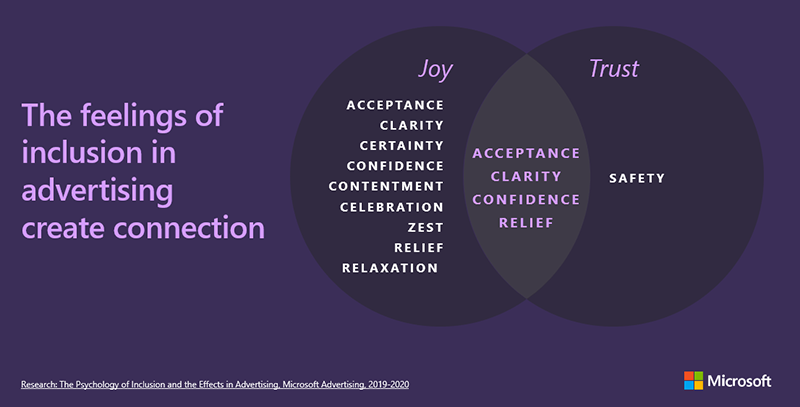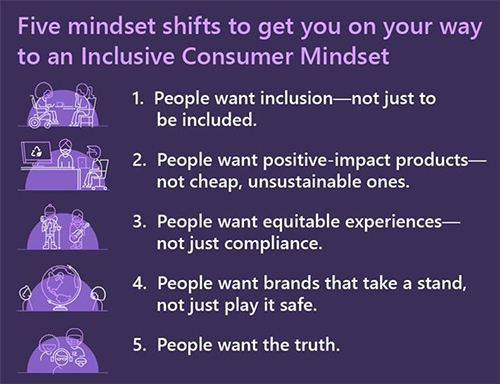Friendships take work. But most of us would agree that the best of them are not only worth our investment, they’re invaluable. Having friends who empathize with us, consider our needs, have our back when the going gets tough, and who just “get us” is what makes life meaningful, right? Never has there been a more poignant time in the world to value one another when we’re striving to stay connected while physically isolated in order to prevent the spread of COVID-19. Genuine care, support, and inclusion of one another, especially the marginalized, has never been more important to the survival of our human race.
So why would our relationships with our customers be any different?
That’s what we wanted to understand when we conducted a series of research studies to explore consumer psychology when it comes to inclusion in advertising as well as what it takes to build trust. And what we learned this past year, as well as from the current state of the world, has led us to an inescapable conclusion:
It’s time to change the way we think about our customer relationships, and know our purpose.
We discovered that 85% of people say they will only consider a brand if they trust the brand and 59% are more trusting of brands that represent them. We also found that 63% of people say brands that represent diversity in their ads are more trustworthy and authentic. Lastly, we found that people will buy from brands that stand for something larger than just their product.
For most brands, this requires a bit of reflection. You see this happening a lot these days as brands consider how they can build trust amidst a global health crisis. They’re thinking about what they can do to help their customers and take the right steps to represent their customers best interests. The concept of knowing your purpose is being stress-tested right now. Yet, through these unprecedented times, we expect that this concept will emerge with stronger importance in how brands build trusting relationships.
Here are some of the questions to consider asking yourself with regards to your customer experiences:
- Do you include them, consider them, represent them, and value them in your brand experience?
- Can you make them feel safe, relieved, confident, or accepted with your product solution, marketing message, service, or experience?
- And most importantly, does your brand stand for something larger than just your product, service, or experience? What higher purpose can your brand authentically deliver on? This is your guiding light in uncertain times, and this is how your values will provide value to others.
Chances are, there’s room for exploration and improvement by all of us. But becoming a brand that genuinely considers customers’ needs, wants, hopes, dreams, fears, and values will pay off when those customers reward you with their trust, love, and loyalty.
We call this an
Inclusive Consumer Mindset. And shifting to this mindset requires understanding what your customers really want and need from their relationship with you. You must have clarity in your brand purpose. Here are five mindset shifts to get you on your way to an Inclusive Consumer Mindset:
1. People want inclusion — not just to be included.
We tend to equate
inclusive marketing with
multicultural marketing — understanding a customer’s cultural heritage, the language they prefer, gender identity, and ethnicity. But it’s much more than that.
Inclusive marketing is understanding what your customer values. It’s recognizing that values drive value for your brand
and your customers. It’s also ensuring that everyone has access to a product, service, or experience that is inclusively designed for them. If we strive towards an inclusive customer experience, not just include them, we become invaluable by providing long-lasting value. This is true for any marketer, any business, in any industry, in any country.
But most important, inclusive marketing is a manifestation of an authentic connection.
Being truly inclusive means matching the needs, wants, values, and variations of human diversity. It’s about understanding what matters to people and what that one individual person needs or cares about, not just creating an ad that looks like them. And when done well in advertising it produces two main feelings that indicate a meaningful, authentic connection and those feelings identified are joy and trust.

2. People want positive-impact products — not cheap, unsustainable ones.
We all make values-based choices every day on what products and brands we will include or exclude in our lives. More and more, our underlying business operation practices
are our marketing. Consumers have never cared so much about brand values —
and they’re voting with their wallets.
Also, consumers care about sustainable products and waste and have taken note, leading to a rise in many eco-friendly products, like the use of plant-based plastics as one example. Almost 90% of millennials and Generation Z will help create more sustainably-produced products by convincing businesses and governments to alter existing practices. And according to the Nielsen report, sales of products with certain sustainability claims grew faster than the overall product category they belonged to. The NYU Stern Center for Sustainable Business completed extensive research into U.S. consumers’ actual purchasing of consumer packaged goods (CPG), and found that
50% of CPG growth from 2013 to 2018 came from sustainability-marketed products.
According to Unilever, half of their business growth five years ago was from three of their brands that had integrated sustainability into both their purpose and products. Collectively, those brands were cited as growing 30% faster than the rest of their business. According to the Global Web Index, some audience groups on the Microsoft Advertising Network are more willing than the average internet user to pay for sustainable and ecofriendly products:
- Veterans are nearly 2.5 times more likely
- Black/African Americans are 91% more likely
- Latinx are 55% more likely
- LGBTQI+ are 39% more likely
One of my favorite examples of this has to do with chocolate. If you know what’s going on in the beginning of the chocolate supply chain, it’s virtually impossible to enjoy this universally loved treat. About two-thirds of the world’s cocoa supply comes from West Africa where, according to a 2015 U.S. Labor Department report, more than 2 million children were engaged in labor in cocoa-growing regions. And the Ivory Coast has lost 85% of its forests since 1990, as extreme poverty pushes people to destroy protected national parks to plant cocoa.
For brands like
Tony’s Chocoloney, the ugly realities of chocolate sourcing pose big challenges, which they incorporated front and center into their brand mission, actively participating in solving the systemic problem. This brand cares deeply about these issues, so they prioritized this mission and impact in their business strategy and marketing approach, knowing that people with shared values will lend their support with product purchase and amplification of their message. They
built a toolkit to help anyone who wants to tell their story of chocolate, but they also
built a bean tracker with block chain and made it available industrywide. And they regularly report back to customers on what they’re doing to address social inequality and environmental damage.
Our relationships with brands and products aren’t much different than our people relationships. We don’t befriend a person simply because they are human. We want to know what they stand for, if their values reflect ours, and if they’re sincere about — and committed to — upholding those values.
3. People want equitable experiences — not just compliance.
Today’s savvy consumers expect brands to go beyond merely complying with regulations. For example, American Disabilities Act (ADA), Web Content Accessibilities Guidelines (WCAG), World Wide Web Consortium (W3C) compliance are all important baselines to get right — both digitally and in public space applications — but effective brands go beyond that to create inclusive experiences that are equitable for everyone.
What packaging are we choosing to use for our products? Do we consider the customer experience all the way through to unpacking a product? One stellar example is the
Xbox Adaptive Controller’s packaging, which created an equitable experience for all with their accessibly designed package for the accessible product.
What working conditions are we choosing to provide to our workforce? Customers want to know that the people who represent your brand are treated fairly, and that they and their families’ basic needs are being met.
This is not just about representation in advertising, but a sense of connection that feels like we are part of a larger family. It’s making a genuine effort to serve people, and build authentic relationships with people, not jumping on a cause bandwagon and woke-washing.
4. People want brands that take a stand, not just play it safe.
Finding the intersection of your brand’s mission with how you can play a part in the world — all while including your customers in creating that shared-value relationship — builds trust. This includes having clarity on your brand values, so customers who share your values can build a mutually meaningful connection with you. And that’s what ultimately builds a loyal relationship.
Take REI’s
Opt Outside campaign. In 2015, REI took the unprecedented step of closing their stores on Black Friday, one of the busiest shopping days of the year. Then they encouraged their employees and all of America to spend that time outdoors. This is a people first approach — being a true friend.
Participants shared their experiences with the hashtag #optoutside, highlighting REI’s community of outdoors-loving customers. Not surprisingly, the campaign lit up social media and was hugely successful that first year, with more than 1.4 million people and 170 organizations participating. REI reported a 9.3% increase in revenues and a 7% increase in comparable store sales in 2015, but its biggest accomplishment was a 23% uptick in digital sales. Year to date, #OptOutside campaign inspired over 7 million people and 700 organizations to participate.
5. People want the truth.
And it’s certainly not about pretending you “get” your audience and doing just enough to come off like you do. Brands need to make an honest effort to understand their customers. Based on that understanding, they must communicate honestly and transparently with them.
Our research found that, in our current landscape, just 47% of consumers believe that most online companies can be trusted with even their most basic personal information. And for Generation Z consumers, it’s only 37%.
This trust deficit can only be addressed when brands are both honest and transparent about their business practices. This includes supply chain practices, fair trade policies, inclusive and accessible experiences — both inside the company and throughout customer experiences. And of course, what companies are doing with consumer data — even when they make missteps.
When you have an honest, genuine, real relationship with your customers, they feel seen and understood. They may even be surprised and delighted that you went out of your way to ensure their customer experience is on point and that you “get them.”
An Inclusive consumer mindset can change the world
We as brands should stop considering humans only in the context of business needs. Consider what people are experiencing in the world around them and what they value, then invite them to build a relationship with you with shared meaning and common values. That’s genuine friendship. Consider how your brand purpose can serve and take action to make the world a better place in a way that's authentic to the brand. This is good for society and meaningful to people, who in turn, can choose your products. By doing this, you can not only drive value in your business — you can shape culture, change communities, evolve with the world, and find long-lasting, meaningful relationships — both in business and personally. You’re the catalyst for change.
